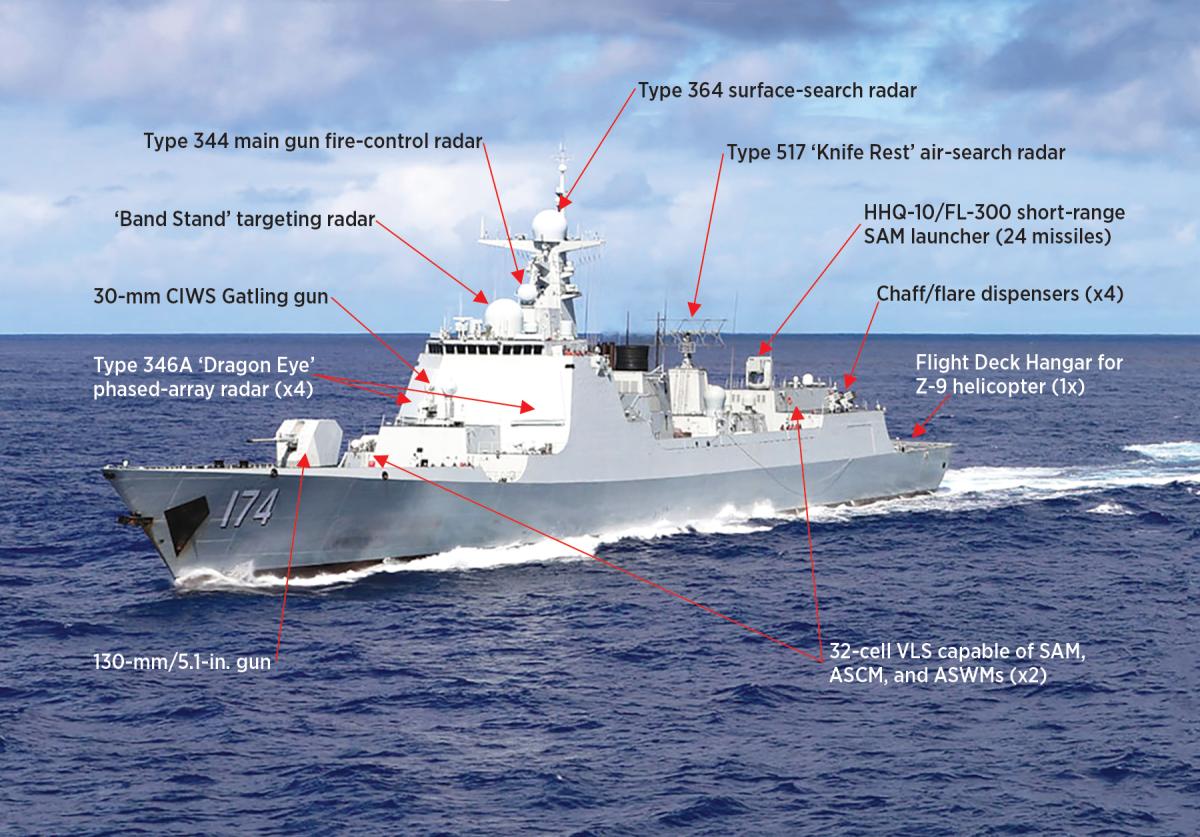Chinese naval threats have grown by leaps and bounds during the past decade. No class of surface warship has demonstrated this newfound naval might more than the modern Luyang III–class guided-missile destroyers, also known as the Type 052D, which began entering service in 2014.
These air-defense destroyers are fitted with the four-panel Type 346A (NATO reporting name: Dragon Eye) multifunction phased-array radar system, which is combined with a 64-cell missile vertical launching system (VLS) to offer long-range area air-defense, modern antiship, and—potentially—land-attack cruise-missile capabilities.
The VLS launchers are fitted in two 32-cell sets, one forward of the helicopter hangar and a second aft of the 5.1-inch gun. Carried inside is a reported mix of HHQ-9 surface-to-air (SAM), YJ-18 antiship cruise (ASCM), and CY-5 antisubmarine missiles.
The HHQ-9 SAM is a naval variant of the Chinese HQ-9, which itself is derived from Russia’s land-based S-300/SA-10 SAM system. Maximum engagement range estimates for the HHQ-9 vary widely across publications, from as little as 55 nautical miles (nm) for early variants to 108 nm, the reported range of the more advanced HHQ-9B variant carried by the Type 052D.
Antiship capabilities are provided by the YJ-18 ASCM, with a range of 290 nm and what is believed to be a 661-pound high-explosive warhead. The CY-5 anti-submarine rocket (AsRoc) system can carry a short-range acoustic-homing torpedo. Additional antisubmarine capabilities are provided by an aft helicopter hangar and landing deck for a single Z-9 maritime helicopter, which is a license-built version of the Eurocopter AS-365 helicopter used by the U.S. Coast Guard under the HH-65 Dolphin designation.
Some reports indicate that these warships also may be fitted with two sets of three torpedo tubes for very-short-range antisubmarine defense. An HHQ-10/ FL-3000N 24-round SAM launcher, similar in appearance to the U.S. Navy’s Mk 49 rolling airframe missile launcher, is installed atop the helicopter hangar to provide point defense out to a maximum range of 5 nm. Last-ditch air defense is provided by chaff/flare launchers to stern and a 30-mm Gatling gun close-in weapons system forward of the bridge. A single 130-mm/5.1-inch gun capable of firing projectiles as far as 16 nm is carried forward.
The Luyang III destroyers can trace their lineage back to the single-hull Luhai-class (Type 051B) destroyer named Shenzhen, which first entered service in 1999. The Shenzhen was followed by two Luyang I–class (Type 052B) destroyers commissioned in 2004. Construction then shifted to the Luzhou (Type 051C) and Luyang II (Type 052C) destroyer classes, which were built on the same hull design as the Luyang I class. The Luyang II (Type 052C), fitted with a phased-array radar and 48-cell vertical-launch system, is considered to be the first Chinese surface combatant possessing true air-defense capability. These warships then evolved modestly into the 7,500-ton Type 052D.
The People’s Liberation Army Navy reportedly has 20 Type 052Ds in active service or being fitted out, including the Hefei (pennant 174, pictured) in service since late 2015, and Taiyuan (pennant number 131), which was commissioned in December 2018.



